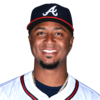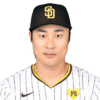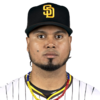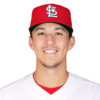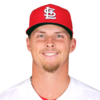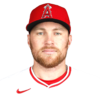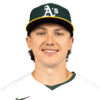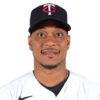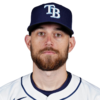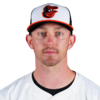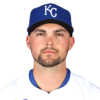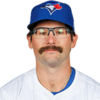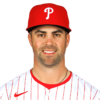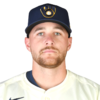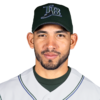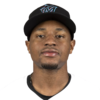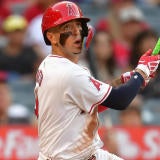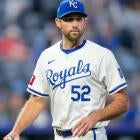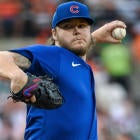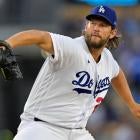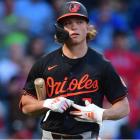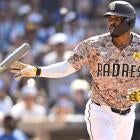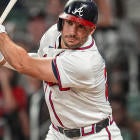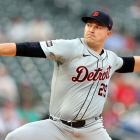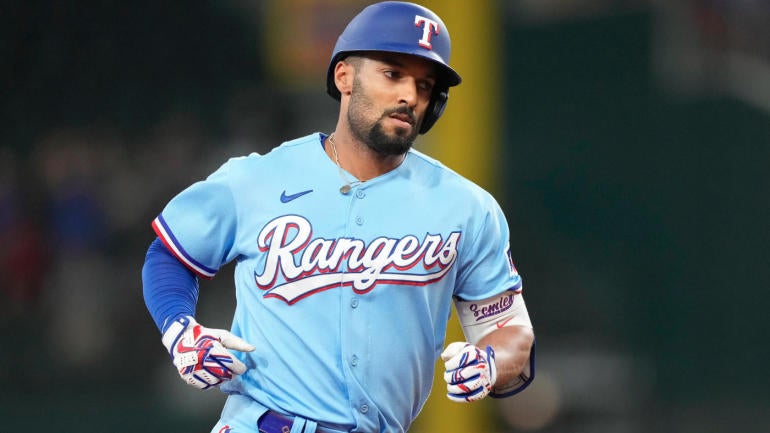
For 2024, at least, there's no more confounding position than second base. It offers such a wide variety of skill types, at all different assurance levels, that it's hard to say exactly what the plan of attack should be.
So maybe ... don't have one. Too chaotic for you? Well, listen, I'm not saying you can't aim for a particular assurance level, be it high end, middle end or low end, but if you go into a draft dead set on landing a base-stealer or slugger or whatever else at second base, then you're missing out on a golden opportunity to regulate mid-draft.
- Position Strategies: C | 1B | 2B | 3B | SS | OF | SP | RP
- Position Previews: C | 1B | 2B | 3B | SS | OF | SP | RP
- Position Tiers: C | 1B | 2B | 3B | SS | OF | SP | RP
That's the best way I can think to describe second base for 2024: it's the ultimate draft regulator. After a few rounds, your team may be skewed a certain way -- toward home runs, toward stolen bases or whatever else -- and second base is your chance to get it back on track. No matter what you need, you can find it there, and the bulk of it is available during that middle portion of the draft when you know exactly what you need.
Naturally, this approach only makes sense for categories leagues, such as standard Rotisserie. For points leagues, it's more straightforward because what a player does isn't as important as how much of it he does. And along those lines, that whole middle portion of second base, which ranges from Nico Hoerner to Zack Gelof by ADP, contributes in about equal measure.
So is that it, then? Just be content with whichever of the many middle-round options best suits your needs? Hey, if you have a chance at a stud early, you can save yourself the fuss and go that route instead. Mookie Betts, Jose Altuve, Ozzie Albies and Marcus Semien contribute in so many categories (and to such overwhelming degrees) that passing on them for a chance to regulate later doesn't make much sense.
But it's such a small group that the timing can be difficult to nail down. And in Betts' case, you're better off using him in the outfield.
| 2024 ADP | 2023 PPG | 2023 BA | 2023 HR | |
|---|---|---|---|---|
Mookie Betts
LAD RF
| 2 | 4.25 | .306 | 39 |
Marcus Semien
TEX 2B
| 23 | 3.64 | .276 | 29 |
Ozzie Albies
ATL 2B
| 24 | 3.63 | .280 | 33 |
Jose Altuve
HOU 2B
| 36 | 3.94 | .311 | 17 |
I've pretty much covered it, haven't I? Let me add that while of course everyone would like to have Semien, Albies or Altuve on his or her team, there may be more obvious choices when that third-round pick comes up. If a player like Francisco Lindor or Vladimir Guerrero is still there, for instance, then I wouldn't blame anyone for going that route instead. I myself would, in part because of the abundance of mid-round targets at second base. Having said that, Semien, Albies and Altuve would all need to be gone before I selected any starting pitcher (unless Spencer Strider or Gerrit Cole somehow fell to their range).
Let me also add that my own personal ranking for them is Altuve, Albies, Semien -- directly the opposite of what's depicted by ADP. Altuve may have some propensity toward injury (though the fractured thumb that cost him so much time last year was obviously just a fluke), but he's the one most likely to deliver a high batting average in addition to the power and speed. The difference in their point-per-game averages last year pretty much tells the story as far as upside is concerned.
| 2024 ADP | 2023 PPG | 2023 BA | 2023 HR | |
|---|---|---|---|---|
Nico Hoerner
CHC 2B
| 57 | 3.36 | .283 | 9 |
Matt McLain
CIN SS
| 78 | 3.41 | .290 | 16 |
Gleyber Torres
NYY 2B
| 92 | 2.97 | .274 | 25 |
Ha-seong Kim
SD 2B
| 99 | 2.90 | .260 | 17 |
Ketel Marte
ARI 2B
| 102 | 3.25 | .276 | 25 |
Andres Gimenez
CLE 2B
| 112 | 2.68 | .251 | 15 |
Bryson Stott
PHI 2B
| 119 | 2.91 | .280 | 15 |
Luis Arraez
MIA 2B
| 134 | 2.96 | .354 | 10 |
Tommy Edman
STL 2B
| 156 | 2.61 | .248 | 13 |
Thairo Estrada
SF 2B
| 165 | 2.75 | .271 | 14 |
Jonathan India
CIN 2B
| 193 | 3.06 | .244 | 17 |
Nolan Gorman
STL 2B
| 207 | 2.71 | .236 | 27 |
Brandon Drury
LAA 2B
| 245 | 2.78 | .262 | 26 |
Ryan McMahon
COL 3B
| 256 | 2.40 | .240 | 23 |
The ADP, as you can see, is quite a bit higher for Nico Hoerner and Matt McLain than the next several on the list, and seeing as they averaged more points per game last year as well, I thought long and hard about grouping them with The Studs instead. But I think both delivered on the full extent of their potential last year and are more likely to slide back into this group than rise to the level of the previous one. Also, on a pure skill level, Hoerner has far more in common with Ha-Seong Kim, Bryson Stott and Andres Gimenez than he does with Altuve and Albies.
Oh, we're doing types now? Yup, this begins the bounty of mid-range second basemen that I referred to earlier, so here is where you can regulate whatever decisions you made earlier in your draft. Hoerner, Kim Stott, and Gimenez would be your preferred choices if you're short on speed, but there are subtler distinctions therein. Hoerner would be the safest bet for batting average of the four but offers the least power, not that any of them offers much. If power is more your priority, then Gleyber Torres might be the pick for you, or you could wait longer and go for Nolan Gorman, who has a chance for even more home runs at the cost of a lower batting average.
The ultimate batting average specialist can be found in this range as well. I'm referring, of course, to Luis Arraez, who hit .354 last year. Just keep in mind that a batting average in the .315-.325 range is more in line with his career norms and a more reasonable expectation for him moving forward. If you're pretty solid everywhere and just want the best overall production you can get (points-leaguers take note), then Ketel Marte is probably your best bet, but I'm not sure you can go wrong with any of these players. The ones who I think are a clear step behind the others are Brandon Drury and Ryan McMahon. Unless your league requires you to start a third middle infielder (like standard Rotisserie does), they're probably not for you.
| 2024 ADP | 2023 PPG | 2023 BA | 2023 OPS | |
|---|---|---|---|---|
Zack Gelof
OAK 3B
| 148 | 3.22 | .267 | .840 |
Edouard Julien
MIN 2B
| 230 | 2.39 | .263 | .839 |
Jorge Polanco
SEA 2B
| 255 | 2.81 | .255 | .789 |
Brandon Lowe
TB 2B
| 259 | 2.78 | .231 | .771 |
Gavin Lux
LAD SS
| 263 | 2.23^ | .276^ | .745^ |
Jordan Westburg
BAL 2B
| 361 | 1.90 | .260 | .715 |
Miguel Vargas
LAD 2B
| 393 | 2.19 | .195 | .672 |
Michael Massey
KC 2B
| 419 | 1.93 | .229 | .655 |
Davis Schneider
TOR 2B
| 458 | 3.39 | .276 | 1.008 |
Justin Foscue
TEX 2B
| ----- | ----- | .266* | .862* |
Thomas Saggese
STL SS
| ----- | ----- | .306* | .903* |
*minor-league stats
^2022 stats
I opted to group Zack Gelof with The Sleepers rather than the Other Deserving Starters because his lack of proven-ness is the only justification I can see for ranking him so far behind Matt McLain. That's not to say McLain is especially proven -- he played in only 20 more games than Gelof last year -- but for whatever reason, drafters are taking his numbers more seriously than Gelof's. Could it be the better ballpark and supporting cast? Perhaps, but McLain has more threats to his playing time. Assessing them purely on skill set, they have the same strengths and weaknesses. While they strike out too much and don't hit the ball especially hard, they also run a lot and rely on launch angles to generate power. If you look at my second base tiers, which are organized more for drafting efficiently than describing accurately, you'll see that McLain and Gelof are in the same one. It may not surprise you to learn, then, that Gelof is the second baseman I've been drafting most often.
He's not the only one who I think could compete with the previous group. Brandon Lowe could still give Nolan Gorman a run for best pure power bat at the position, but his platoon risk and recurring back issues are obvious detractions. The trade that sent Jorge Polanco to Seattle eliminated the possible playing time conflict between him and Edouard Julien, and both could emerge as must-start players this year. Polanco has been there before but, like Lowe, has struggled to stay healthy in recent years. Julien has a profile that's difficult to project, combining superlative on-base skills with quality exit velocity readings, but he also has some concerning strikeout numbers and an aversion to pulling the ball in the air. We'll see how much he plays against left-handers.
Those are the ones I'm most excited about from this group. In a deep enough Rotisserie league, someone is going to have to draft Gavin Lux and Justin Westburg, but I prefer Davis Schneider to both. He ran hot and cold in his brief major-league stint last year but showed that the on-base skills and pull-side power will translate.
| 2024 ADP | 2023 SB | 2024 hope | Also eligible | |
|---|---|---|---|---|
Mookie Betts
LAD RF
| 2 | 14 | 10-15 | OF |
Marcus Semien
TEX 2B
| 23 | 14 | 15-20 | ----- |
Ozzie Albies
ATL 2B
| 24 | 13 | 15-20 | ----- |
Jose Altuve
HOU 2B
| 36 | 14 | 15-20 | ----- |
Nico Hoerner
CHC 2B
| 57 | 43 | 40-50 | SS |
Matt McLain
CIN SS
| 78 | 14 | 20-30 | SS |
Gleyber Torres
NYY 2B
| 92 | 13 | 10-15 | ----- |
Ha-seong Kim
SD 2B
| 99 | 38 | 30-40 | 3B, SS |
Andres Gimenez
CLE 2B
| 112 | 30 | 30-40 | ----- |
Bryson Stott
PHI 2B
| 119 | 31 | 30-40 | ----- |
Zack Gelof
OAK 3B
| 148 | 14 | 20-30 | ----- |
Tommy Edman
STL 2B
| 156 | 27 | 30-40 | SS, OF |
Thairo Estrada
SF 2B
| 165 | 23 | 20-30 | SS |
Jonathan India
CIN 2B
| 193 | 14 | 15-20 | ----- |
Whit Merrifield
TOR 2B
| 250 | 26 | 20-30 | OF |
Jordan Westburg
BAL 2B
| 361 | 4 | 10-15 | 3B |
Brice Turang
MIL 2B
| 366 | 26 | 20-30 | SS |
Jose Caballero
TB 2B
| ----- | 26 | 20-30 | SS |
Xavier Edwards
MIA 2B
| ----- | 32* | 20-30 | ----- |
*minor-league stats
Fair to say this position is fertile ground for stolen bases. We've covered most of these players -- and their potential for steals -- already, but I failed to mention earlier that Tommy Edman and Thairo Estrada make for quality fallback options if you miss out on Ha-Seong Kim, Bryson Stott and Andres Gimenez. Maybe Whit Merrifield, too, if he lands with a team that intends to play him every day. Brice Turang and Jose Caballero, on the other hand, probably won't hit enough to make their base-stealing worthwhile, but I am intrigued by Xavier Edwards, whose versatility could make him a semi-regular on a Marlins team that seems to value speed. He has a little bit of Luis Arraez in him, too, having hit .351 at Triple-A Jacksonville last year with a microscopic strikeout rate.




